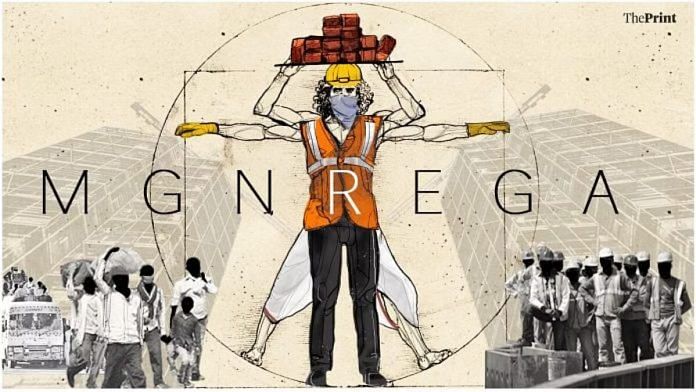New Delhi: After streamlining attendance and the wage payment system, the Centre plans to use technology to identify projects under the Mahatma Gandhi National Rural Employment Guarantee Scheme (MGNREGS) for efficient resource management and sustainable rural development, ThePrint has learnt.
The Union Ministry of Rural Development plans to implement Yuktdhara, a Geographic Information System (GIS-based) portal. According to a ministry official, the portal will recommend a list of works that can be executed in a Gram Panchayat under MGNREGS.
The decision to use satellite-based data in the planning of MGNREGS works comes after the Centre made online attendance and the Aadhaar Based Payment System (ABPS) mandatory for the payment of wages to workers—with some exceptions—in the past two years.
Officials said the National Remote Sensing Centre under the India Space Research Organisation helped develop the Yuktdhara portal.
“It (Yuktdhara) will simplify planning for MGNREGA works by using satellite and map-based data to automatically suggest and identify the best locations for works like water conservation and afforestation,” the ministry wrote in response to ThePrint’s query.
“This will promote sustainable rural development, efficient resource utilisation, and climate-responsive planning at the Gram Panchayat level,” the ministry added. It plans a phased implementation for the technology next year.
Currently, Gram Panchayats identify MGNREGS works or projects at the start of each financial year. While officials in several states are helping Gram Panchayats identify such work using GIS tools, officials said that the existing system does not recommend the type of projects.
“We have to go through the information about the list of geo-tagged MGNREGS assets and the GIS data of the area, among others—separately—while planning works. This new portal will help check duplication of work in the area, recommend projects based on the geographical condition, etc.,” Iaraphunlin Diengdoh, joint mission director of the State Rural Employment Society in the Meghalaya government.
The list of works the portal recommends will be put before the Gram Panchayat for approval.
A senior ministry official said, “It will help to identify nature conservation projects, such as locations for the construction of ponds, check dams, and plantation sites, among others. It will help the Gram Panchayats make more informed decisions based on the ground situation. There will be no possibility of duplication of assets.”
The portal, by streamlining projects, will also help to weed out corruption.
Last week, the rural development ministry held a training session for the implementation of the new technology for northeastern states.
According to a senior ministry official, four regional hands-on workshops will be in December 2024. “All states and Union Territories have identified one Gram Panchayat per block for the Phase-I roll-out, during which the portal will be enabled for Gram Panchayat-level planning. Field officials from these Gram Panchayats will serve as master trainers for the subsequent nationwide roll,” the ministry, in its response, said.
Portal to recommend projects
Under MGNREGS, many projects are related to plantation, water conservation, etc., apart from the construction of Anganwadi centres, animal sheds and housing, among others, under the Pradhan Mantri Awas Yojana.
The Yuktdhara portal will map the works permissible under MGNREGS into two categories, the Geospatially Analysable Works (GAW) and Non-GAW. GAW works are mostly related to the conservation of natural resources.
“There is a provision of Landscape Familiarisation module in Yuktdhara, where the portal gives details regarding the landscape of the particular Gram Panchayat and provides a holistic view of thematic resources and existing datasets of the Gram Panchayat,” the official said.
Thematic resources, an official said, include information on geomorphology, groundwater prospects, land-use cover, wasteland, salt-affected regions, waterlogged regions, etc.
The portal will also provide information about the existing assets in the region—created under various schemes, including the MGNREGS and the Integrated Watershed Management Programme (IWMP).
“The portal will automatically provide suggestive site locations for the identified permissible activity of MGNREGS based on geospatial analysis. It will enhance and ensure the scientific and robust planning of works related to watershed development and natural resource management under the scheme,” a ministry official said.
“Though the portal will recommend projects, the Gram Panchayat will take the final decision on the list of approved projects,” said a senior official with the Tamil Nadu government’s rural development department.
(Edited by Madhurita Goswami)
Also Read: No meetings of MGNREGA watchdog for nearly 4 yrs due to delayed appointments; process on now






